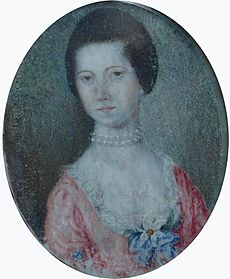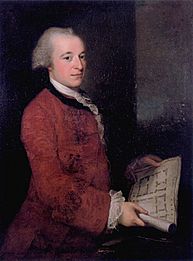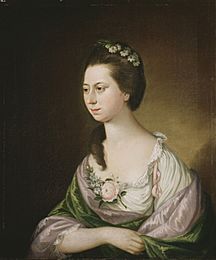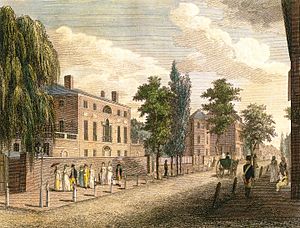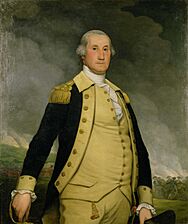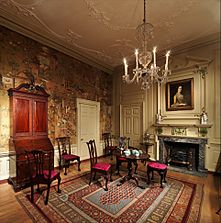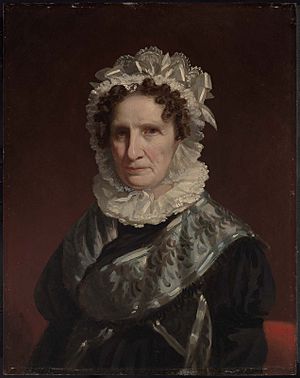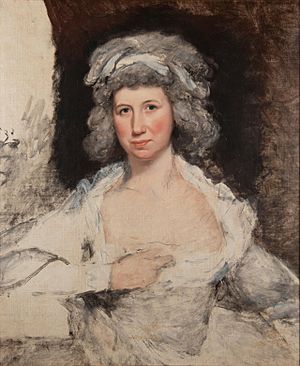Elizabeth Willing Powel facts for kids
Quick facts for kids
Elizabeth Willing Powel
|
|
|---|---|
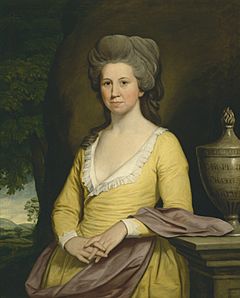
Portrait of Elizabeth Willing Powel
by Matthew Pratt, c. 1793 |
|
| Born |
Elizabeth Willing
February 21, 1743 |
| Died | January 17, 1830 (aged 86) Philadelphia, Pennsylvania, U.S.
|
| Resting place | Christ Church Burial Ground |
| Spouse(s) |
Samuel Powel
(m. 1769; died 1793) |
| Parents |
|
| Relatives |
|
| Signature | |
Elizabeth Willing Powel (February 21, 1743 – January 17, 1830) was an important American patriot and a leading figure in Philadelphia society during the founding of the United States. She was known for hosting popular gatherings called salons, where the nation's leaders came to discuss politics and philosophy.
Powel was a close friend and trusted advisor to George Washington. She helped convince him to serve a second term as president. She is also famous for a conversation she had with Benjamin Franklin. She asked him what kind of government the new country would have. He replied, "A republic... if you can keep it." This quote is still famous today.
Contents
Early Life and Family
Elizabeth Willing was born in Philadelphia on February 21, 1743. Her father, Charles Willing, was a successful merchant who served twice as the mayor of Philadelphia. Her mother, Ann Shippen, came from a wealthy family. Elizabeth grew up in a large family with ten brothers and sisters.
Because her family was wealthy, Elizabeth received a good education, which was not common for girls at the time. Her letters show that she was very intelligent and well-read. As a young woman, she was expected to marry and start a family.
Marriage to Samuel Powel
On August 7, 1769, Elizabeth married Samuel Powel. Samuel was one of the richest men in Philadelphia. Their marriage united two of the city's most powerful families. They lived in a large home on South Third Street, which is now known as the Powel House.
Elizabeth and Samuel had four children, but sadly, all of them died at a very young age. This caused Elizabeth great sadness for the rest of her life. She often wrote about her feelings of loss in her letters to friends and family.
A Famous Hostess
During the 1770s, as American leaders gathered in Philadelphia for the First Continental Congress, Elizabeth Powel began hosting parties and dinners. These events were known as salons. A salon was a gathering where smart and influential people could discuss important topics like politics, art, and philosophy.
Powel's salons became very popular. By hosting these events, she played an important role in the political life of the new nation. At a time when women could not hold office, hosting a salon was a way for a woman like Elizabeth to share her ideas and influence the country's leaders.
Her parties were known for their lively conversations and amazing food. John Adams, who later became the second president, once wrote about a "most sinful feast" at her house with "twenty kinds of tarts" and many other delicious desserts.
Role in the American Revolution
When the American Revolutionary War began, the Powels stayed in Philadelphia. Samuel Powel was elected mayor in 1775, becoming the last colonial mayor of the city. During the war, British soldiers occupied Philadelphia and used the Powel House as their headquarters. The Powels had to live in the servants' quarters of their own home.
After the war, Elizabeth's salon became even more important. It was a central part of the "Republican Court", which was the social circle of the new nation's leaders.
Friendship with George Washington
Elizabeth Powel was a very close friend of George Washington and his wife, Martha Washington. When Washington was in Philadelphia for the Constitutional Convention in 1787, he visited the Powels often. His diary shows he spent more time at their home than anywhere else.
Their friendship was built on respect. They saw each other as intellectual equals. In 1792, President Washington told Powel he was thinking about retiring after his first term. Powel was worried this would be bad for the young country.
She wrote him a long, powerful letter, urging him to run for a second term. She argued that the country still needed his leadership. Many historians believe her letter was a "decisive stroke" that convinced Washington to stay on as president. Their friendship continued until his death in 1799.
Later Life and Beliefs
Samuel Powel died in 1793, leaving his large fortune to Elizabeth. She never remarried and spent the next 30 years managing the family's business and properties. This was very unusual for a woman at the time.
Elizabeth had strong opinions and was not afraid to share them.
- On Women's Roles: She believed women should be well-educated. However, she also thought that women were not suited for government, a common view at the time.
- On Slavery: Elizabeth was born into a family that owned enslaved people. However, later in her life, she came to strongly oppose slavery. In her will, she wrote, "I abhor slavery," and left money to the Pennsylvania Abolition Society to help end it.
Elizabeth Powel died on January 17, 1830. She was buried next to her husband at Christ Church in Philadelphia.
"A Republic, If You Can Keep It"
The most famous story about Elizabeth Powel involves Benjamin Franklin. In 1787, as the Constitutional Convention was ending, the new U.S. Constitution had just been written.
According to the story, Powel saw Franklin and asked him, "Well, Doctor, what have we got, a republic or a monarchy?"
Franklin famously replied, "A republic, if you can keep it."
This short conversation carried a big message. Franklin was saying that the new government was a republic—a country where the people hold the power—but that it would take hard work from its citizens to keep it strong.
Over the years, the story was often retold, but Elizabeth Powel's role was sometimes forgotten. Many people started saying that an "anonymous lady" or a "concerned citizen" had asked the question. But historical records show that the smart and engaged woman who asked this crucial question was Elizabeth Willing Powel.
Legacy
Elizabeth Willing Powel is remembered as an intelligent and influential woman who played a key part in the social and political life of the early United States.
- The Powel House: Her home at 244 South Third Street in Philadelphia is now a museum. It has been restored to look as it did in the 18th century.
- Her Letters: Hundreds of her letters have survived. They give us a special look into her life and the lives of America's founders.
- Her Portraits: Several portraits of her still exist, showing her at different stages of her life.
Through her salon, her friendship with leaders like Washington, and her famous question to Franklin, Elizabeth Willing Powel helped shape the new American nation.
See Also
 In Spanish: Elizabeth Willing Powel para niños
In Spanish: Elizabeth Willing Powel para niños


